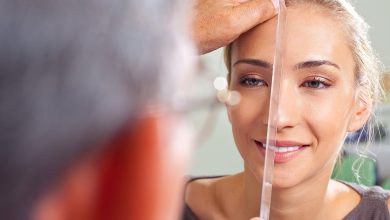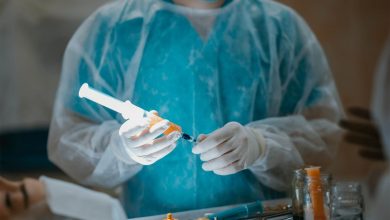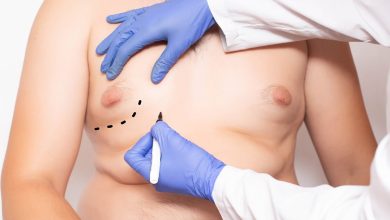Breast Reduction Surgery
What is Breast Reduction Surgery?
Breast reduction, also known as reduction mammoplasty, is a surgical procedure performed using some surgical techniques to reduce the breast to a size proportional to the body and to reshape it in such a way as to ensure an aesthetic appearance, by removing excess breast tissue, skin and fat tissue from a sagging breast that is larger than normal. Breast reduction surgery successfully treats excessively large breasts, which causes serious psychological and physical health problems since adolescence.
How is Breast Reduction Surgery Performed?
Breast reduction surgery (reduction mammoplasty) is performed under general anesthesia in an operating room, using various surgical techniques determined according to the size of the breast and the degree of sagging. In this surgical procedure;
- Breast mass is reduced to normal sizes,
- The sagging nipple is raised to the ideal level, i.e. a breast lift procedure is performed,
- The breast is aesthetically reshaped.
While doing these, care is taken;
- To preserve the blood circulation in the nipple and the dark-colored area surrounding it (nipple-areola complex),
- To preserve the nipple’s functional sense,
- To preserve the breast production and breastfeeding capacity.
Causes of Large Breasts
The condition characterized by abnormal enlargement of the breast beyond the normal proportion is called breast hypertrophy and is also referred to as macromastia, hypermastia, or gigantomastia depending on the degree of largeness. Due to various factors, the breasts can grow unilaterally or bilaterally to extremely large sizes at any period of life, either gradually over years or rapidly within days. Based on their incidences, the reasons can be listed as follows:
- Idiopathic type;There is no specific cause that can be identified. It is the most common type. It is usually accompanied by conditions such as obesity and hormonal imbalance.
- Puberty-induced type (juvenile type): It is probably triggered by sex hormones between 11 and 19 years of age.
- Pregnancy-induced type:It is the type induced by pregnancy hormones, mostly in the first 3 months of pregnancy. It is observed in 1 out of every 100,000 pregnancies.
- Drug-induced type:It is induced by some drugs such as D-penicillamine and cyclosporine.
- Autoimmune diseases due to immune system disorders: They are associated with disorders such as SLE, Hashimoto’s thyroiditis, chronic arthritis, and psoriasis.
- Menopausal periods
- Excessive weight gain
Grades of the bigness of breast
- Mild: The excess is less than 300 grams
- Moderate: The excess is between 300 and 800 grams
- Advanced: The excess breast and adipose tissue is more than 800 grams. The tissues removed during the operation are weighed and recorded in the surgical operation report.
Disadvantages of Large Breasts
- Psychological problems: In particular, it may cause serious physical and psychological problems in an adolescent girl who has very large breasts compared to her friends. It may cause problems such as weakened self-confidence, the woman’s dissatisfaction with the appearance of her own body and associated problem such as social isolation.
- Shoulder, back and neck pain due to weight of the breasts.
- Postural disorders.
- Restriction in some physical activities, such as running.
- Difficulty in expanding the lungs enough to breathe, especially when lying down.
- Rashes, wounds and skin infections under the breasts.
- Breasts that do not look aesthetically beautiful may cause a woman to dislike her body.
- Difficulty in finding clothes: Due to her large breasts, the women cannot wear clothes produced in normal standards, and additional processing is required on the clothes due to the difference between the lower and upper body sizes.
Benefits of Breast Reduction Surgery
It provides various physical, mental, and psychosocial benefits by making the breast aesthetically pleasing and proportional to the body.
- It eliminates back, neck and shoulder pain.
- It solves problems such as rash on breast skin.
- The woman begins to breathe and move more easily, and her decreased physical activities increase.
- The woman finds herself more beautiful, becomes more positive spiritually, and her self-confidence improves.
- The clothing problem is resolved, and she can easily wear whatever she has wanted for years.
- Psychosocial depression decreases, and the woman establishes more positive relationships with her environment.
- As a result of the decrease in the breast tissue mass, the risk of developing breast cancer decreases as well.
Characteristics of A Candidate Who is Suitable for Breast Reduction Surgery
If you have the following characteristics, you can consider having a breast reduction operation;
- Her breast growth has stopped and she has no hormonal disease
- She is healthy, both physically and mentally
- She has realistic expectations from the surgery
- She is nonsmoker
- Her body mass index is within normal limits (she is not obese)
- She finds her breasts big and unaesthetic
- She has excessively large breasts that limit her physical activities
- She suffers from neck, shoulder and back pains due to the size of her breasts
- She has grooves on her shoulders, caused by bra straps.
She has rashes and skin irritations in her inframammary folds.
Acceptable Age for Surgery
Normally, it is essential that the person has completed puberty and at least 6 months have passed since the end of the breast growth. However, in cases where the breasts reach excessively large sizes during adolescence and cause serious psychological and physical disorders in the adolescent, breast reduction surgery can be performed at an earlier age after consultations with endocrinology and psychiatry specialists.
Before Breast Reduction Surgery
- During the preoperative interview, a detailed investigation is carried out to evaluate the patient in terms of both breast diseases and general physical and mental health, and then the breasts are photographed, and measurements are made.
- If any, the medical problems experienced in the breasts and the treatments administered for the breasts are discussed.
- The rules that must be followed in all aesthetic surgeries, which are presented to your attention under the heading “Dos and Don’ts before surgery” on the home page of our website, should be followed and necessary preparations should be made.
- In addition to all these preparations, a general surgery specialist should be consulted to get a routine breast examination, and the current condition of the breast should be revealed by mammography and ultrasonography.
- Smoking should be stopped at least 1 month before the surgery to reduce the risk of complications due to a possible circulatory disorder in the nipple and suture lines.
- An interview is held with the anesthesiologist of the hospital where the surgery will be performed and the necessary tests are performed.
Planning the New Breast Size
The amount of tissue to be removed during the breast reduction operation and the size of the breast that will be newly formed cannot be determined solely by the patient’s or physician’s preference. A breast that is considered aesthetic as a standard is determined by some measurements and proportions, such as the width of the areola, and the relationship between the nipple and inframammary fold.
Surgery is planned by taking into account many factors such as the width of the chest cage of the person to be operated, the width of the breast base, the distance between the nipple and the collarbone, the distance from the nipple to the inframammary fold, and the quality of the breast skin.
Due to the problems they have been through for years, women sometimes want their breasts to be very small. In such a case, it should be explained to the patient that any breast excessively small compared to the body would not look aesthetically beautiful, and then a more normal breast size should be planned.
Breast Reduction Procedures and Surgical Techniques
Breast reduction surgery is performed in full-fledged hospitals under general anesthesia. Before the operation, on the day of the operation, the plastic surgeon who will perform the procedure makes drawings and markings on the breasts according to the surgical technique to be applied.
To prevent clot formation in the legs, the patient wears antithrombotic socks. The patient is then taken to the operating room, and the operation is started under general anesthesia.
- Liposuction alone: In selected cases where the breast skin is not excessively loose and saggy and the amount of fat tissue is higher than that of breast tissue, it is possible to reduce the breast to some extent by performing “liposuction” alone, without making any incisions on the breast skin. In some cases, especially excess fat extending towards the armpits can be removed by liposuction that can be performed in conjunction with some tissue removal techniques.
- In the “Free nipple graft”technique, the nipple and the pigmented area around it (nipple-areola complex) are removed at the beginning of the surgery, by making a circular incision, and is set aside; and after the excess tissue is removed and the breast reshaped, this nipple-areola complex is sutured where it should be on the breast. This technique is especially preferred in patients with excessively large breasts, diabetic patients, heavy smokers, and in cases where there is a risk of circulatory disorders in the nipple. It is not possible to breastfeed after an operation performed with this technique, because the milk ducts are disconnected from the nipple and the nipple sensation cannot be restored the same as before.
- Techniques in which the nipple-areola complex is preserved with a pedicle while other areas are removed.The common point of these surgical techniques is that they preserve, i.e. do not surgically touch, the nipple-areola complex (the nipple and its surroundings) and some breast tissue through which blood vessels and milk channels pass to support this structure with blood circulation. This breast tissue preserved as a whole together with the nipple is called “pedicle”. This pedicle also allows for preserving the lactation and breastfeeding feature of the breast. This structure known as the pedicle that is preserved from surgical intervention is named according to its location in the breast. Depending on the location of the pedicle in the breast, surgical techniques can involve;
- Central pedicle
- Medial pedicle (from the inner aspect of the breast)
- Lateral pedicle (from the outer part of the breast)
- Superior (from above) pedicle
- Supero-medial pedicle (from the above-inner aspect of the breast)
- Supero-lateral pedicle (from above-outer part of the breast)
- Inferior (from below) pedicle
- Vertical double pedicle
- Horizontal double pedicle.
The goal of choosing a pedicle is to provide the best blood circulation and sensory support to the nipple while still having adequate amount of breast tissue to reshape the breast. There is no single and ideal pedicle type, so the size of the breast, the degree of sagging, and the surgeon’s experience and personal preferences, all play a role in pedicle selection.
In the surgery, the excess skin and breast tissue are removed, while the predetermined nipple and pedicle, which are marked on the breast in advance, are preserved. Therefore, the pedicle is chosen from the location that remains out of the area selected for tissue removal. For example, if we will remove tissues from the lower pole of the breast, the pedicle should be a central, superior, supero-medial, or supero-lateral pedicle.
In my practice, I prefer the superior pedicle in mild cases and the supero-medial pedicle in more severe cases. When I use these pedicles, I have the opportunity to completely remove the lower pole of the breast, which causes the breast’s original drooping appearance and paves the way for the future recurrence of the sagging problem.
Types of Breast Reduction Scars
The incisions made on the breast skin to remove excess skin at the beginning of the operation leave scars of various shapes when the the parts of the skin are sutured in their new positions. The most common ones of these scars are;
- 1- Periareolar (Donut): Around the areola, there is a circular scar alone.
- Vertical (Lollipop — Keyhole): In addition to the circular scar around the areola, a scar line extends vertically from the areola down to the midline, forming the shape colloquially known as “lollipop”.
- Inverted-T (Anchor): In addition to the circular scar around the areola and the vertical scar at the lower pole, there is a horizontal scar in the inframammary fold.
- Horizontal-only: In addition to the scar around the areola, there is only a horizontal scar at the level of the inframammary fold, while there is no vertical scar at the lower pole of the breast.
- J-shape:There is the scar extending down from the scar around the areola and takes the shape of the letter J in the inframammary fold.
- L-shape: There is the scar extending vertically down from around the areola, which has a horizontal component that extends outward in the inframammary fold.
The aforementioned scars are used to leave as short and less visible scars as possible while removing the excess breast skin. “Vertical” incisions are most often made for medium-sized breasts, while “Inverted-T” incisions are most often made for larger breasts. According to my own personal experience, the most important factor affecting the satisfaction of the patient with the surgical result is the aesthetic shape of the breasts rather than the size of the scars.
When inadequate amount of skin is removed with intent to leave a shorter scar, puckers remain in the breast skin, the breast does not take the desired aesthetic shape, and mostly, a revision surgery is required. Therefore, I believe that the amount of skin that needs to be removed should be removed without hesitation, regardless of how many scars will remain.
- In the surgery, after the excess tissues are removed and the breast is reshaped, drains are placed in the operation area to discharge the accumulated fluid, the incisions are closed with self-dissolving subcutaneous sutures, and the surgery is terminated after dressing is applied and a corset is put on the patient.
- The removed breast tissues are sent to the laboratory for pathological examination to rule out the possibility of any breast diseases. According to reports, previously undiagnosed breast cancers are detected in 3-4 of every 1000 breast reduction materials sent for routine pathological examination in this manner. Treatment of these conditions detected at an early stage is also easier.
Risks and Complications of Breast Reduction Surgery
- Blood accumulation in the breast
- Infection
- Changed nipple and skin sensation
- Circulatory disorder in the nipple and breast skin, and associated partial or full skin loss It is more common in people with a smoking history, who continues to smoke after surgery
- Wound dehiscence at the suture lines
- Scar formation in the incision lines due to poor wound healing (hypertrophic scar, keloid) and scar enlargement
- Asymmetry,
- Aesthetically unsatisfactory result.
After Breast Reduction Surgery
- The patient begins to eat, gets up, and walks 4-6 hours after the operation.
- The first postoperative night is spent in the hospital.
- Drains are removed after 1 to 3 days depending on the amount of fluid discharge.
- The dressings are removed after 7 to 10 days, and then the patient can take a shower.
- Creams that will help the incision scars heal more aesthetically are applied for a period of several months.
- The special corset without underwire is used for 2 to 3 months.
- The patient can return to work one week after the operation as long as she doesn’t strain her arms too much.
- After the operation, it takes 3-6 months for the breast to take its final shape in terms of aesthetic appearance, and it should be waited patiently. If any retouching or revision is required, it is necessary to wait at least 6 months or even a year to see the final result and intervene it accordingly.
- Surgical scars, which are initially more visible, take two years to take on their final appearance, so patience is required.
Does Breast Reduction Surgery Cause Cancer?
Far from causing cancer, breast reduction surgery also indirectly reduces the risk of cancer development by reducing the amount of breast tissue that can potentially develop cancer. On the other hand, pathological examination of the breast tissue removed during breast reduction surgery allows for early diagnosis of cancers.
Can I Breastfeed My Baby After Breast Reduction Surgery?
Except for the “free nipple graft” technique, the nipple is moved to some extent in the form of a block that also contains the mammary gland and milk ducts, in such a way as to preserve the lactation function.
How Long After Surgery Can I Breastfeed?
Because the pregnancy period will be between your surgery and breastfeeding, adequate time will have passed.
How Long After The Breastfeeding Period Can I Have Surgery?
It is beneficial to wait at least 6 months, and even 1 year, for the mammary glands to return to their previous state.
How Long Does a Breast Reduction Operation Take?
It may take 3 to 5 hours, or even longer, depending on the technique used.
Is Non-Surgical Breast Reduction Possible?
Unfortunately, there is no effective breast reduction method other than surgical correction. However, when overweight people lose weight, their breast size may decrease to some extent. If a medication or disease is the cause of the breasts enlargement, it should be eliminated first.
Can the Nipple Be Reduced As Well?
To avoid causing an additional risk of circulatory problems, I don’t interfere with the nipples during breast reduction operations. Instead, I prefer performing the nipple reduction procedure separately under local anesthesia a few months after the operation.
Is It Possible To Have A Breast Lift Procedure At The Same Time?
As a routine, all breast reduction operations also involve the breast lift procedure; in other words, the nipple is moved to a higher position where it should be. In addition, the enlarged areola is reduced and made more symmetrical.
Does A Breast Reduction Surgery Leave Scars?
The procedure leaves a scar on the breast skin, to an extent that may vary depending on the surgical technique used. It takes 2 year for the incision scars to take their final form. In most cases, these scars are hardly noticeable, but depending on the people’s wound healing characteristics, the procedure may leave more noticeable scars.
When Will I Be Able To Wear a Bra and How Can I Choose the Right Bra?
Do not rush to choose a bra for the new size of your breast; instead, wear the special bra corset given by your surgeon for a period of at least two months. You may even need to wear a smaller size of the same corset 1-2 weeks after the operation, depending on the improvement of the edema in breasts. After 2-3 months, buy a bra by trying it on, and choose a bra that fits the breast well without pressing on the incision scars.
How Long Will I Stay In The Hospital?
It is adequate to stay in the hospital for one night if there is no medical or social conditions requiring longer periods.
Breast Reduction Prices in 2024
Costs of breast reduction surgery vary depending on the hospital where the operation will be performed, the extent of breast reduction, and the surgeon who will perform the procedure. You can contact our clinic to get the most up-to-date prices.
References
Frequently Asked Questions (FAQ)
Are breast reduction operations painful?
The day after the surgery, there is no need to take any painkillers or only simple painkillers such as paracetamol are needed. If the patient experiences severe pain, swelling, or tension in her breasts after surgery, this could be a sign of a complication called blood accumulation (hematoma) in the breast, so she should contact the plastic surgeon who performed the surgery.
When does the pain subside after breast reduction surgery?
When can I return to work after breast reduction surgery?
Does age have any effect on breast reduction surgery?
A surgical operation can be planned if there is no significant increase in the breast volume in a period of 6 months after the patient turns 18 years old On the other hand, breast reduction surgery can also be performed at a younger age after consultations with endocrinology and psychiatry specialist if the breast is large enough to cause serious physical and psychological problems.
When the Control Examinations Are Performed by The Surgeon After Breast Reduction Surgery?
In my practice, I ask my patients to visit me on the 3rd and 5th days after surgery for the removal of drains and the first change of dressing. I perform another examination 10 days after the operation. Unless there is a condition that requires closer monitoring, I plan routine follow-up examinations at the 1st, 3rd, 6th, and 12th months after the operation.
Can breasts regrow after breast reduction surgery?
Does the result of breast reduction surgery differ from person to person?
On the other hand, it is difficult to ensure absolute symmetry between the breasts after a breast reduction operation involving both breasts. The patient should be ready for minor asymmetries. If there is still a noticeable asymmetry after at least 6 months, it is corrected with a revision operation under local anesthesia. In particular, I would like to state that smokers are more likely to encounter unwanted conditions such as circulatory disorder at the nipple, suture line dehiscence or poor wound healing.
To what extent should the breasts be reduced in breast reduction surgery?
However, sometimes adequate breast reduction could not be achieved. It is possible to reduce the breasts that have not been reduced enough with a revision operation, but there is no solution other than a silicone implant placement to re-enlarge a breast that has been excessively reduced. Despite the availability of some programs that simulate the shape and size of the breast to be obtained after surgery, the actual results may not always match the results displayed on the computer screen. In my practice, I do not give my patients exact bra measurements before surgery, and I recommend them to wait about 2 months after surgery to choose a bra size according to the final shape of their breasts.




